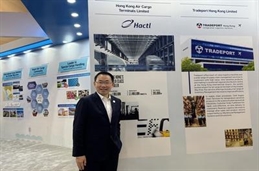
Hong Kong Air Cargo Terminals Limited (Hactl) is anticipating Hong Kong’s new three-runway system to significantly enhance the city’s air cargo volumes and strengthen Hong Kong International Airport’s (HKIA) status as a major international aviation hub.
Wilson Kwong, chief executive of Hactl, HKIA’s largest independent air cargo handler, said the three-runway system will progressively raise capacity at the airport and present many opportunities for the Hong Kong air cargo sector.
“The three-runway system is a very significant milestone for Hong Kong, and it will present many opportunities going forward,” he told Asia Cargo News. “There will be more opportunities, and I’m very confident that there will be new partnerships, more partnerships.”
Kwong explained that before the three-runway system, Hong Kong International Airport was operating close to capacity, so it was very difficult to get slots.
“If a new airline wanted to operate, you apply for slots, and they would say, ‘Oh, [there’s] not enough or not at your desired times,’” Kwong said. “But now, with the three-runway system, there are fewer restrictions. That means more slots. So, therefore, you can have more airlines operating into Hong Kong, and the pie gets bigger.”
“This also means further enhancing the air cargo supply chain between Hong Kong to the rest of the world,” Kwong added.
HKIA ended 2024 on a high note, recording a double-digit increase in cargo volumes for the year, mainly driven by strong exports. During the year, the airport handled a total cargo throughput of 4.9 million tonnes, representing an annual growth of 14%.
The Airport Authority of Hong Kong (AAHK) commissioned HKIA’s three-runway system on November 28 in a boost to the development of Hong Kong’s aviation sector while expanding capacity to meet future air traffic demand.
Once all three runways are operating, it will increase HKIA’s annual capacity to 10 million tonnes of cargo. The airport – the world’s busiest cargo hub – has a current cargo capacity of 5 million tonnes per year.
The Dongguan Intermodal initiative linking Dongguan Logistics Park to HKIA also presents opportunities.
Kwong told Asia Cargo News that although still on the pilot scheme, the sea-air intermodal transhipments between Dongguan and HKIA would “enlarge the catchment” for cargo.
The sea-air model seeks to enhance the time efficiency and cost-effectiveness of cargo transhipment services for the Greater Bay Area (GBA). Under the new intermodal model, security screening, palletization and acceptance for GBA’s export cargo can be completed in advance in Dongguan and then shipped seamlessly to the airside of HKIA by sea for direct air transhipment to overseas destinations without the need to undergo security screening again at HKIA.
When the Logistics Park and the new model are fully operational, it is expected to reduce operating costs by about 50%, and handling time by about one-third.
Kwong said the intermodal scheme will also serve as a “complement” to trucking services. “The majority of the cargo will still be transported by road, but Dongguan is a complementary route,” he told Asia Cargo News.
Aside from Hong Kong, the GBA consists of nine cities in the Pearl River Delta of Guangdong Province (Guangzhou, Shenzhen, Zhuhai, Foshan, Dongguan, Zhongshan, Huizhou, Jiangmen and Zhaoqing) and Macau – an integrated economic area with a consumer market of approximately 7.52 million people in South China.
The Hactl chief executive expressed optimism for the continued surge in ecommerce, which has recently been driving global air cargo growth.
“The ecommerce trend will not reverse because people are now used to buying things online,” Kwong told Asia Cargo News. “Everyone wants to have the goods they purchased, like yesterday. They don’t want to wait long. So, how are they going to ship it fast? Air cargo will be the natural step.”
For Hactl, aside from Hong Kong’s new three-runway system, ecommerce will also continue to be a significant growth driver for 2025.
“I think there will be ongoing demand from ecommerce. Barring unforeseen circumstances, I think there will be continual growth in ecommerce,” Kwong said, adding that 2024 has also been a “busier year” for Hactl driven by ecommerce and continued disruption in ocean shipping, which shifted some of the cargo to air.
Despite rising trade and geopolitical tensions, Kwong remains optimistic about the long-term prospects of air cargo while cautioning about uncertainties in the near future.
“Any trade frictions are not good for trade because it adds compliance costs. The more barriers [there are], the more significant the impact on trade. And in a world which is increasingly interconnected, you need trade to be more free-flow,” Kwong said.
“There are so many uncertainties, but as an air cargo stakeholder, I would urge, of course, that the less trade frictions we impose on the industry, the better. Because ultimately, we are affecting the consumers.”
Nonetheless, Kwong noted that the air cargo industry, in general, is “very agile.”
“Trade links will change. Trade mix will change,” Kwong told Asia Cargo News. “And air cargo is very good at changing with it as well. So, I’m still very positive about air cargo in the medium and long term, definitely. But short term, yes, there may be uncertainties.”
He explained that, in addition to increasing trade tensions and disruptions in ocean shipping, capacity is also strained due to growing challenges related to shortages of spare parts needed to build and fix aircraft.
“My take is, of course, [air cargo growth] will not reverse. This trend will not reverse. Secondly, there will always be new products to ship. And there will be an increase in regional trade, particularly in Asia. All these additional demands of air cargo,” Kwong said.
“As a result, I’m actually bullish about air cargo. Despite the short-term challenges, short-term uncertainty.
By Charlee C. Delavin
Asia Cargo News | Hong Kong



